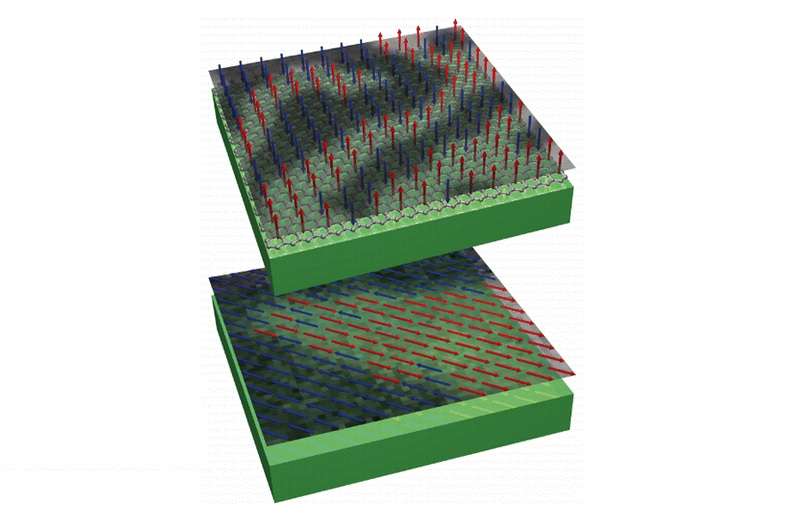December 21, 2015 feature
Giant enhancement of magnetic effect will benefit spintronics

(Phys.org)—Researchers have demonstrated that coating a cobalt film in graphene doubles the film's perpendicular magnetic anisotropy (PMA), so that it reaches a value 20 times higher than that of traditional metallic cobalt/platinum multilayers that are being researched for this property. In a material with a high PMA, the magnetization is oriented perpendicular to the interface of the material's layers. High-PMA materials are being researched for their applications in next-generation spintronic devices, such as high-density memories and heat-tolerant logic gates.
The researchers, Hongxin Yang, et al., have published a paper on the giant PMA enhancement in a recent issue of Nano Letters.
In general, spintronic devices work by using magnetic and electric fields to switch electron spins between their two states, which allows the spins to be used as binary information carriers. One of the goals in this area is to reduce the size of spintronic devices while achieivng long-term information retention of 10-plus years. In order to do this, the storage material must have a large PMA.
"Perpendicular magnetic anisotropy (PMA) at ferromagnetic transition-metal/insulator interfaces has become of huge interest in the context of development of various spintronic devices," coauthor Mairbek Chshiev, a theoretical physicist and professor at Joseph Fourier University in Grenoble, France, told Phys.org. "Enhancement of effective PMA could be achieved either by increasing the surface PMA or by minimizing the saturation magnetization of the storage layer. The co-graphene heterostructures presented in the manuscript benefits from both these properties."
As the researchers explain in their paper, the PMA enhancement in the graphene-coated cobalt films originates at the atomic level, where graphene affects the energy of cobalt's different electron orbitals. The graphene coating changes how these orbitals overlap with one another, which in turn changes the direction of the cobalt film's overall magnetic field: some of the magnetization that was originally parallel to the film surface is now oriented perpendicular to the film surface.
The graphene-coated cobalt has another advantage, which is that the film can be made significantly thicker than other high-PMA materials. Typically, high-PMA materials can only be five or so layers thick before their perpendicular magnetism spontaneously starts to reorient itself in the parallel direction. The researchers here demonstrated that graphene-coated cobalt can maintain its perpendicular orientation even at 13 layers thick, which is another benefit for applications.
"To further optimize the downsize scalability of spintronic devices, the effective PMA of the storage layer has to be maximized so that the thermal stability factor remains high enough to achieve a long-term retention in gigabit applications," Chshiev said.
The researchers hope that these results, which demonstrate the large PMA enhancement provided by the graphene coating, will make graphene-cobalt structures promising candidates for future spintronic devices. They plant to continue investigating other high-PMA materials in the future.
"We will explore other material combinations with low spin-orbit coupling yet high PMA values for traditional and graphene spintronic devices in vertical geometry, including magnetic tunnel junctions," Chshiev said. "Spin orbitronics phenomena in lateral graphene-based devices will also be explored."
More information: Hongxin Yang, et al. "Anatomy and Giant Enhancement of the Perpendicular Magnetic Anisotropy of Cobalt−Graphene Heterostructures." Nano Letters. DOI: 10.1021/acs.nanolett.5b03392
Journal information: Nano Letters
© 2015 Phys.org



















